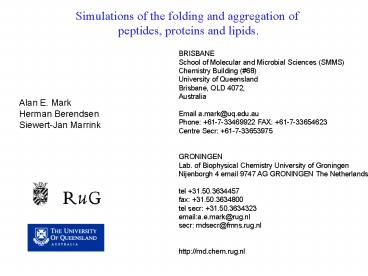Simulations of the folding and aggregation of PowerPoint PPT Presentation
1 / 15
Title: Simulations of the folding and aggregation of
1
Simulations of the folding and aggregation of
peptides, proteins and lipids.
BRISBANE School of Molecular and Microbial
Sciences (SMMS)Chemistry Building
(68)University of QueenslandBrisbane, QLD
4072,AustraliaEmail a.mark_at_uq.edu.auPhone
61-7-33469922 FAX 61-7-33654623Centre Secr
61-7-33653975GRONINGEN Lab. of Biophysical
Chemistry University of Groningen Nijenborgh 4
email 9747 AG GRONINGEN The Netherlands tel
31.50.3634457fax 31.50.3634800 tel secr
31.50.3634323emaila.e.mark_at_rug.nl secr
mdsecr_at_fmns.rug.nl http//md.chem.rug.nl
Alan E. Mark Herman Berendsen Siewert-Jan Marrink
2
Peptide folding and assembly
- Our best example of peptide folding to date is a
the beta-hexapeptide shown - on the following slides (solvent Methanol).
- This system is fully reversible.
- We have simulations of this and other systems to
gt 200ns at temperatures - from 180 -gt to 450K.
- We have replica exchange simulations of a
slightly modified system - showing 1000s of individual folding events.
- As far as we can determine our modified system
approaches full - convergence in 200-400 ns.
- 5. Trajectories are available.
3
?-Peptides
- ?-amino-acids (additional backbone carbon)
- Stable 2nd structure.
- Non-degradable peptide mimetics
- (e.g. highly selective somatastatin analogue)
?-Heptapeptide (M) 31-helix in MeOH at 298
K (left-handed)
D. Seebach, B. Jaun coworkers organic chem
ETH-Zurich
Daura, X., Bernhard, J., Seebach, D., van
Gunsteren, W. F. and Mark, A. E. (1998) J. Mol.
Biol. 280, 925-932.
4
?-Heptapeptide, 340 K
unfold
fold
unfold
fold
fold
unfold
unfold
5
Starting structure
?-Heptapeptide, 360 K
?Gfolding -RT ln (folded/unfolded)
6
Predict Probability of Individual Microstates in
Solution
?G6 kJ/mol
?G8 kJ/mol
?G0 kJ/mol
?G9 kJ/mol
?G9 kJ/mol
Daura, X., van Gunsteren, W. F. and Mark, A. E.
(1999) Proteins Struct. Funct. Genet. 34,
269-280.
7
Folding Pathways
8
Simulations of peptide folding
As part of our program we are looking a range of
larger peptides. So far getting reversible
folding from random starting structures has
proved difficult for systems gt 20 a.a. In
particular we are investigating a series of
related helical peptides (20 a.a.) with fast
folding kinetics
AP A5(A3RA)3A
YGA Ac-YG(AKA3)2AG-NH2
YGG Ac-YGG(KA4)3K-NH2
So far results are limited but we have seen
reversible transitions. An example is given
below.
9
AP A5(A3RA)3A
Ref Lednev I. K. et al. J. Am. Chem. Soc. 1999,
121, 8074-8086.
- A 21 amino acid, mainly alanine, a-helical
peptide (AP). - The folding/unfolding activating barriers based
on an nanosecond UV resonance Raman study. - 8 kcal/mol activation barrier reciprocal rate
constant 24060 ns at 37 C (310 K).
MD simulation start from the a-helix
structure The GROMOS 45A3 force field was adopted
10
The secondary structure as a function of time
shows one refolding transition in 100ns.
Secondary structure
Residue
Time (ps)
11
C-ter
N-ter
N-ter
N-ter
C-ter
N-ter
C-ter
30 ns
50 ns
C-ter
10 ns
0 ns (starting structure)
N-ter
C-ter
N-ter
N-ter
C-ter
C-ter
C-ter
N-ter
N-ter
C-ter
85 ns
75 ns
70 ns
80 ns
100 ns
12
- Other peptide systems on which we have
simulations showing partial - folding or assemble include
- Various amyloid forming peptides on surfaces.
- Betanova (a designed triple stranded peptide)
- A series of coiled-coils.
- WW domain peptide (20 a.a. peptide studied by
replica exchange) - Several proteins showing recovery from mild
denaturing conditions.
13
Spontaneous Aggregation of Lipids and Surfactants
I believe this is one area where complexity
analysis should be able to perform well as the
systems show spontaneous generation of order.
- We have multiple simulations of
- Bilayer formation (course grained and in atomic
detail) - Vesicle formation (course grained and in atomic
detail) - Phase transitions (course grained and in atomic
detail) - Membrane and vesicle fusion.
Note these are highly reproducible collective
processes involving 100s to 1000s of lipids. A
few examples are given below.
14
Spontaneous assembly of phospholipds into a
bilayer
A
C
B
0 ns
0.2 ns
3 ns
Ceq
Deq
C
25 ns
20 ns
10 ns
S.J. Marrink
15
Density Evolution Showing the Generation of Order
density
water
head groups
lipid tails
S.J. Marrink

